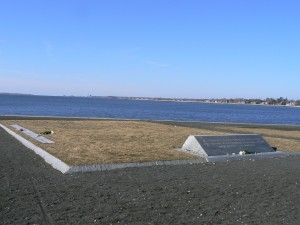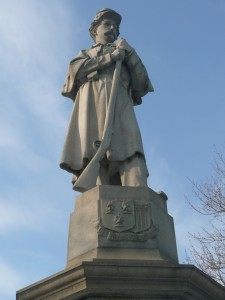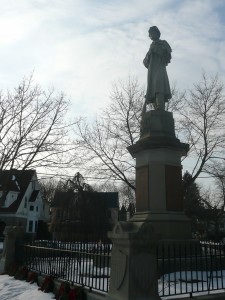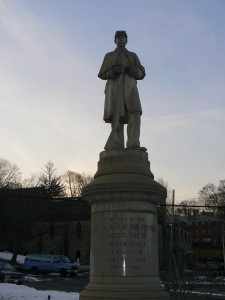 The state of Connecticut’s monument honoring residents who were killed in the terrorist attacks on Sept. 11, 2001, sits in a well-landscaped section of Sherwood Island State Park in Westport.
The state of Connecticut’s monument honoring residents who were killed in the terrorist attacks on Sept. 11, 2001, sits in a well-landscaped section of Sherwood Island State Park in Westport.
The state’s 9/11 Living Memorial features a dark granite monument inscribed with a dedication on its northeast face reading “The citizens of Connecticut dedicate this living memorial to the thousands of innocent lives lost on September 11, 2001 and to the families who loved them.”
The memorial is in the Sherwood Point section of the park, overlooking Long Island Sound on a small section of land extending beyond the park’s beaches.
 The northwest and southeast sections of the memorial are lined with two rows of granite markers bearing the names of 152 residents who died in the attacks. Visitors have placed sea shells, flowers and other mementos on many of the markers.
The northwest and southeast sections of the memorial are lined with two rows of granite markers bearing the names of 152 residents who died in the attacks. Visitors have placed sea shells, flowers and other mementos on many of the markers.
Four benches stand to the northeast of the large granite monument, and the area around the memorial features gravel pathways and shrubbery to create a peaceful area for quiet reflection.
Standing in front of the granite monument, viewers face southwest toward Manhattan and the former site of the World Trade Center. On a clear day, the Twin Towers were visible, and on Sept. 11, smoke from the fallen towers could be seen from the location of the memorial.
Tags: Westport
 A tall obelisk in the middle of a small Norwich park honors the members of the 26th Regiment, Connecticut Volunteer Infantry, who served in the Civil War in late 1862 and mid-1863.
A tall obelisk in the middle of a small Norwich park honors the members of the 26th Regiment, Connecticut Volunteer Infantry, who served in the Civil War in late 1862 and mid-1863.
The monument, dedicated in 1902 in Little Plain Park (between Broadway and Union Street), is a obelisk divided into several sections by ornamental details. A dedication on the monument’s south face reads “To the memory of the 26th Regiment Conn. Volunteer Infantry.”
Just above the dedication, the south face also bears the name “Port Hudson” and a pair of crossed rifles with a wreath, symbolizing the regiment’s service in the infantry. A cross-like symbol appearing on all four sides of the monument is likely a regimental or a corps emblem.
The north face bears some statistics about the unit, listing its original enrollment of 825 members and a breakdown of its 278 casualties: 52 killed in action, 142 wounded and 84 died in service (mostly likely from disease).
 A regiment comprised primarily of Norwich residents, the 26th’s major engagement was the siege of Port Hudson, La., between May 21 and July 9, 1863. The capture of Port Hudson, together with the capture of Vicksburg, Miss., a few days earlier, gave Union forces effective control of the Mississippi River and provided an important turning point in the Civil War.
A regiment comprised primarily of Norwich residents, the 26th’s major engagement was the siege of Port Hudson, La., between May 21 and July 9, 1863. The capture of Port Hudson, together with the capture of Vicksburg, Miss., a few days earlier, gave Union forces effective control of the Mississippi River and provided an important turning point in the Civil War.
The 26th was organized in Norwich on Nov. 10, 1862, and arrived in New Orleans on Dec. 16. The unit first served at Camp Parapet, a former Confederate fort north of New Orleans that had been captured by Union forces. The unit was shifted to the siege of Port Hudson on May 24, and participated in two ill-fated assaults (on May 27 and June 14) that produced no military benefit for the Union, but did create a large number of casualties.
When word reached Port Hudson on July 9 that Vicksburg had surrendered to Union forces on July 4, the Confederate leaders at Port Hudson similarly surrendered.
Sources:
Connecticut Historical Society: Civil War Monuments of Connecticut
Wikipedia – Siege of Port Hudson
Tags: Norwich
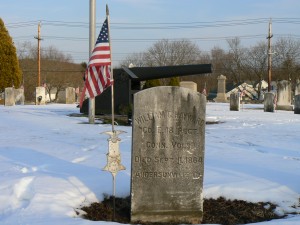 A large Civil War cannon is featured in a section of Norwich’s Yantic Cemetery is dedicated to veterans including nine residents who died as prisoners of war in the Confederate prison at Andersonville, Ga.
A large Civil War cannon is featured in a section of Norwich’s Yantic Cemetery is dedicated to veterans including nine residents who died as prisoners of war in the Confederate prison at Andersonville, Ga.
The nine Norwich veterans who died in the prison were reinterred in Yantic Cemetery on February 1, 1866 after a day of ceremonies that included a parade. The nine graves are arranged in a circular pattern, and several other veterans of the Civil War and later conflicts were added to the area in later years.
A marker near the cannon explains that 15 Norwich residents died in Andersonville. Norwich, the first northern city to retrieve its Andersonville dead, sent representatives to the site after the war. Only the 10 who could be identified were returned to their native city. Nine were reburied in Yantic Cemetery, and one was reburied in his family’s plot in the city’s Center Cemetery.
 The cannon (a 4.2 inch, 30-pounder Parrott Rifle manufactured in 1862) has been painted several times over the years, but recently layers of paint were scraped away on the muzzle and barrel to reveal markings by its manufacturer.
The cannon (a 4.2 inch, 30-pounder Parrott Rifle manufactured in 1862) has been painted several times over the years, but recently layers of paint were scraped away on the muzzle and barrel to reveal markings by its manufacturer.
Camp Sumter, the Confederate name for the prison constructed in Andersonville, Ga., opened in February 1864 to house Union prisoners of war. The site was enlarged in June of that year, and by August, more than 33,000 prisoners were being confined in a 26.5 acre site largely without shelter or sanitary facilities. Large numbers of prisoners were moved from Andersonville in late 1864 during Sherman’s raids on Georgia, and the population eventually settled down to an average of about 5,000.
 By the end of the war, nearly 13,000 Union soldiers had died from disease, malnutrition and exposure to the elements.
By the end of the war, nearly 13,000 Union soldiers had died from disease, malnutrition and exposure to the elements.
The site of Camp Sumter has been restored and is maintained by the National Park Service. The site also features the National Prisoner of War Museum and an active National Cemetery.
An “Andersonville Boy” statue honoring Connecticut residents who died in captivity was erected in 1907 on the former prison site. A contingent of 103 prison survivors traveled to Georgia for the dedication ceremonies. A copy of the statue stands on the grounds of the state capitol complex.
Sources:
Connecticut Historical Society: Civil War Monuments of Connecticut
Andersonville National Historic Site (National Park Service)
Tags: Norwich
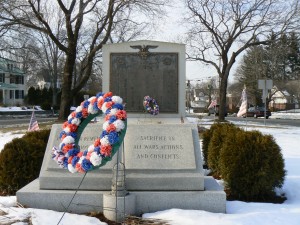 A small triangular park just north of the Soldiers’ Monument in Norwich features monuments to the major wars of the 20th Century as well as to an early American who helped settle the design of the U.S. Flag.
A small triangular park just north of the Soldiers’ Monument in Norwich features monuments to the major wars of the 20th Century as well as to an early American who helped settle the design of the U.S. Flag.
The area between Broadway and Washington Street, near the Chelsea Parade park, features a granite and bronze monument to the first World War, as well as granite monuments honoring those lost in World War II, Korea and Vietnam, as well as the Vietnam POWs/MIAs.
The south end of the park, along William Street, features a small granite marker bearing a dedication to those who were lost in “all wars, actions and conflicts.” The marker contains a small eternal flame enclosed in glass.
Both faces of the World War monument feature large bronze plaques topped by eagles and the U.S. star emblem, and bear the dedication “to the men and women of Norwich who served their country in the War War.” The years 1917 and 1918 appear within wreaths. Both sides feature nine columns of local residents who served in the conflict, with stars indicating the names of residents who were killed.
 North of the World War monument is a granite monument honoring those lost in the Second World War on the east face (toward Broadway) and the Korean war on the west face (toward Washington Street). The World War II dedication reads: “To commemorate those who served in World War II and to those who paid the supreme sacrifice in order that our nation may continue to the glory of God and to continue in his principles amongst men this monument is dedicated and in solemn memory of those who paid the supreme sacrifice in Vietnam 1964 1975.” (The other side expresses a similar dedication to those who served in Korea).
North of the World War monument is a granite monument honoring those lost in the Second World War on the east face (toward Broadway) and the Korean war on the west face (toward Washington Street). The World War II dedication reads: “To commemorate those who served in World War II and to those who paid the supreme sacrifice in order that our nation may continue to the glory of God and to continue in his principles amongst men this monument is dedicated and in solemn memory of those who paid the supreme sacrifice in Vietnam 1964 1975.” (The other side expresses a similar dedication to those who served in Korea).
The prisoners of war and missing in action from Vietnam are honored in a dark granite monument north of the World War II monument that bears a polished POW/MIA logo.
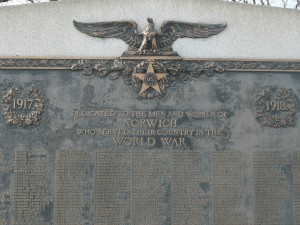 The POW/MIA logo is repeated in the Vietnam War monument, which stands to the immediate north. That monument bears the dedication “In honor of the brave servicemen who gave their lives in Vietnam” above a dozen names and dates of death.
The POW/MIA logo is repeated in the Vietnam War monument, which stands to the immediate north. That monument bears the dedication “In honor of the brave servicemen who gave their lives in Vietnam” above a dozen names and dates of death.
A nearby Freedom Tree is dedicated to a local service member captured or reported missing in 1973.
A small rock north of these monuments bears a plaque dedicated to Capt. Samuel Chester Reid (1783-1861), a Norwich native who commanded a privateer ship during the War of 1812 and who helped design the 1818 version of the United States flag. The 1818 flag established the convention of adding a star to represent each state (the nation had 20 states at the time, but the flag had 15 stars and 15 stripes) while retaining 13 stripes to represent the original colonies.
Tags: Norwich
 A large 1875 monument to soldiers killed in the Civil War stands near the northern end of the Chelsea Parade green in Norwich.
A large 1875 monument to soldiers killed in the Civil War stands near the northern end of the Chelsea Parade green in Norwich.
The monument features a caped infantryman standing with two hands wrapped around the barrel of his rifle. Unlike most monuments, in which the figure is gazing straight ahead, the Norwich soldier is looking downward and to his left, making him appear a bit more reflective or contemplative than the average monument figure.
The soldier, unusually large among the state’s Civil War monuments at 12 feet, stands atop an eight-sided column with ornate decorative elements near the top. The front (south) face bears the Connecticut and U.S. shields just below the soldier’s feet.
 Four of the eight columns bear an estimated 160 names and regimental affiliations of local residents who were killed in the war. Unlike many Connecticut Civil War monuments, the Norwich monument does not feature a list of battles in which local residents participated.
Four of the eight columns bear an estimated 160 names and regimental affiliations of local residents who were killed in the war. Unlike many Connecticut Civil War monuments, the Norwich monument does not feature a list of battles in which local residents participated.
The monument is surrounded by a tasteful iron fence that features four matching granite corners bearing the U.S. shield on the outer faces. At the time of our visit, earlier in March, seven wreaths lay at the base of the monument’s fence.
Near the south side of the monument’s base, a smaller granite marker indicates a time capsule was buried in 1959 to mark the city’s 300th anniversary. The time capsule is scheduled to be opened 50 years from now in 2059, which in all likelihood means someone besides us will have to report what they find.
 The vintage postcard image posted below bears a 1908 postmark.
The vintage postcard image posted below bears a 1908 postmark.
Source:
Connecticut Historical Society: Civil War Monuments of Connecticut
Tags: Norwich
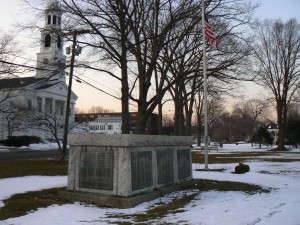 A granite monument to the Norwalk soldiers who fought and died in the first World War sits on the Norwalk Green, near the intersection of East Avenue and Park Street.
A granite monument to the Norwalk soldiers who fought and died in the first World War sits on the Norwalk Green, near the intersection of East Avenue and Park Street.
The monument, first dedicated in 1921, consists of five granite slabs mounted in a rectangular shape. The front (south) face bears the dedication “This monument is erected as a tribute of honor to the citizens of Norwalk, Conn., who devoted themselves to the cause of freedom in the service of our country during the great world war 1917-1919 and as a memorial to the men who made the supreme sacrifice.” Beneath this dedication are the names of 45 residents lost in the war.
The sides of the monument feature seven bronze plaques bearing an estimated 1,200 names of Norwalk residents who fought in the conflict.
 The front plaque also refers to a cannon “that surmounts this monument” being donated to the city in 1921 by the Republic of France, but a casual glance reveals a lack of cannons atop the monument.
The front plaque also refers to a cannon “that surmounts this monument” being donated to the city in 1921 by the Republic of France, but a casual glance reveals a lack of cannons atop the monument.
The French cannon, dating back to 1877, was removed from the monument in 1950, when the monument was moved from its original location on Belden Avenue outside the Norwalk Library. Between then and late last year, the cannon stood outside the local VFW post.
According to a Norwalk Hour article from last December, the cannon, which was captured by the Germans and recaptured by the French during the war, was moved into storage for restoration and reinstallation on the World War Monument.
Tags: Norwalk
 The town of Greenwich offers an impressive collection of monuments along Greenwich Avenue.
The town of Greenwich offers an impressive collection of monuments along Greenwich Avenue.
A granite monument outside the Greenwich Commons “pocket park” (in front of the Board of Education offices) was dedicated in 1956 to honor those lost in World War II and subsequent conflicts. The monument depicts a WWII-era solider staring toward the south with a woman and a young girl kneeling or standing at his side. Beneath this image is the dedication “in reverent memory of those from the town of Greenwich who made the supreme sacrifice World War II Korea Vietnam”.
In front of the monument, a large flagpole with an eight-sided granite base carries the names of Greenwich residents lost in World War II and Korea. Seven panels bear 185 names of World War II heroes, and one panel has 13 names of residents who were lost in Korea.
To the south of the monument, a smaller granite marker carries 24 names of local residents killed in the Vietnam War.
 Near this monument is a statue of military aviation pioneer Raynal C. Bolling, who was killed in the first world war. Beneath a bronze statue of Bolling looking to the sky is a simple inscription bearing only his last name. The rear of the monument is inscribed with his name and biographical information, as well as an explanation of Bolling’s role in the early days of military aerial combat.
Near this monument is a statue of military aviation pioneer Raynal C. Bolling, who was killed in the first world war. Beneath a bronze statue of Bolling looking to the sky is a simple inscription bearing only his last name. The rear of the monument is inscribed with his name and biographical information, as well as an explanation of Bolling’s role in the early days of military aerial combat.
Bolling Air Force base in Washington, D.C, is named for the aviator.
The sculptor of the Bolling monument, Edward Clark Potter, also created the lions outside the New York Public Library, the statue of General Henry Warner Slocum in Gettysburg and other monuments.
Near the Bolling monument is a tree that was planted April 9, 1914 by the Grand Army of the Republic, the post-Civil War-era veteran’s organization. Unfortunately, the dedication listed on the bottom half of the marker (which has apparently been disturbed by the tree’s roots) is covered by grass and soil, and we didn’t think the local police would be pleased by the efforts of a monument blogger found uncovering the inscription.
 A little further south on Greenwich Avenue is the town’s World War monument, a 50-foot obelisk that sits in a small park in front of the town’s Post Office. The obelisk has a multi-sided base bearing the dedication “in honor of the men and women of Greenwich who served in the World War” as well as “in memory of those who died and an inspiration to all who follow.”
A little further south on Greenwich Avenue is the town’s World War monument, a 50-foot obelisk that sits in a small park in front of the town’s Post Office. The obelisk has a multi-sided base bearing the dedication “in honor of the men and women of Greenwich who served in the World War” as well as “in memory of those who died and an inspiration to all who follow.”
Another side of the base lists the following battles: Second Battle of the Marne, North Sea, St. Mihel, Ypres Lis, Meuse Argonne and Verdun.
(The images in today’s post were taken in late February, when the tree near the World War monument still had Christmas decorations. The town’s Civil War monument, at Maple and East Putnam avenues, was highlighted in an earlier post.)
Tags: Greenwich
 The Soldiers’ and Sailors’ Monument in South Norwalk stands in a small park near the intersection of West Washington Street and Martin Luther King Drive.
The Soldiers’ and Sailors’ Monument in South Norwalk stands in a small park near the intersection of West Washington Street and Martin Luther King Drive.
The granite monument, dedicated in 1900, depicts a caped infantry soldier, facing southeast, who is holding the barrel of a rifle. He stands atop a round column engraved with a dedication reading “Erected by the Grand Army of the Republic and the citizens of South Norwalk in memory of her loyal sons 1861-1865.”
The back of the column is stamped with the dedication date of October 20, 1900. The monument sits on a four-sided base, with each face bearing the symbol for a Civil War military specialty: infantry, cavalry, artillery and the navy.
 Shrubbery lines the walkway leading to the monument from Martin Luther King Drive.
Shrubbery lines the walkway leading to the monument from Martin Luther King Drive.
A copper box in the monument has a list naming schoolchildren who contributed to the monument’s fundraising effort.
(The images for this post were taken in early March, when snow covered a lot of Connecticut.)
Source:
Connecticut Historical Society: Civil War Monuments of Connecticut
Tags: Norwalk
 The Soldiers’ Monument at the corner of West Street and Main Street in Danbury was dedicated in 1880 to honor local Civil War heroes.
The Soldiers’ Monument at the corner of West Street and Main Street in Danbury was dedicated in 1880 to honor local Civil War heroes.
The monument differs from the Civil War monuments in other Connecticut towns in a number of ways. First, it features a round column, instead of the more-common four-sided, pointed shaft. Second, the standard-bearing figure topping the granite column was carved from Italian marble.
Additionally, the highlighted battles are listed in a spiral pattern that starts from the base of the monument and scrolls up to the decorative details beneath the standard-bearer’s platform.
The monument’s front (east) base bears a dedication “to our brothers, beloved, honored, revered, who died that our country might live.” Just above the inscription, a wreath hook has been drilled into the monument’s base. The rear face reads “the defenders of the Union.”
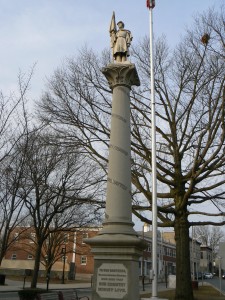 On the column, the monument lists the following battles: Bull Run (near Manassas, Va.), Wilderness (near Spotsylvania, Va.) Antietam (Sharpsburg, Md.), Fredericksburg (Va.), Gettysburg, Chancellorsville (Va.), Petersburg (Va.) and Port Hudson (La.). Since the battles don’t follow chronological or alphabetical order, we’re not sure how the sequence was determined.
On the column, the monument lists the following battles: Bull Run (near Manassas, Va.), Wilderness (near Spotsylvania, Va.) Antietam (Sharpsburg, Md.), Fredericksburg (Va.), Gettysburg, Chancellorsville (Va.), Petersburg (Va.) and Port Hudson (La.). Since the battles don’t follow chronological or alphabetical order, we’re not sure how the sequence was determined.
The monument sits in a small triangular park that also features a flagpole, a decorative lamppost and tasteful shrubbery along its West Street sides.
Tags: Danbury
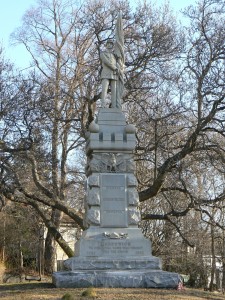 Greenwich’s Soldiers’ and Sailors’ Monument, dedicated in 1890, sits on a hill at the intersection of East Putnam and Maple avenues.
Greenwich’s Soldiers’ and Sailors’ Monument, dedicated in 1890, sits on a hill at the intersection of East Putnam and Maple avenues.
The monument is topped by a standard-bearer, similar to monuments in Unionville and St. Bernard’s Cemetery in New Haven that have been highlighted in previous posts.
The Greenwich monument faces south, and an inscription just above the base bears the town name and a dedication “to her loyal sons who fought for the Union,” as well as the years of the Civil War. The front of the monument also lists three battle sites: Kingston (Ga.), Morris Island (S.C.) and Antietam.
The east side of the monument lists Appomattox, Gettysburg, Vicksburg and Port Hudson (La.). The south side lists Drury’s Bluff, Petersburg and Deep Run (all in Virginia), and the west side lists New-Berne (N.C.) , Darbytown Road (Va.), Fort Fisher (N.C.) and Fort Gregg (S.C.).
Across Maple Avenue, a 1932 plaque on the Second Congregational Church commemorates a 1789 visit by George Washington, who “paused here on the Post Road near this church and afterward wrote in his diary ‘the superb landscape which is to be seen from the meeting house is a rich regalia.’” The plaque was dedicated as part of Washington bicentennial celebrations.
Sources:
Connecticut Historical Society: Civil War Monuments of Connecticut
Tags: Greenwich

